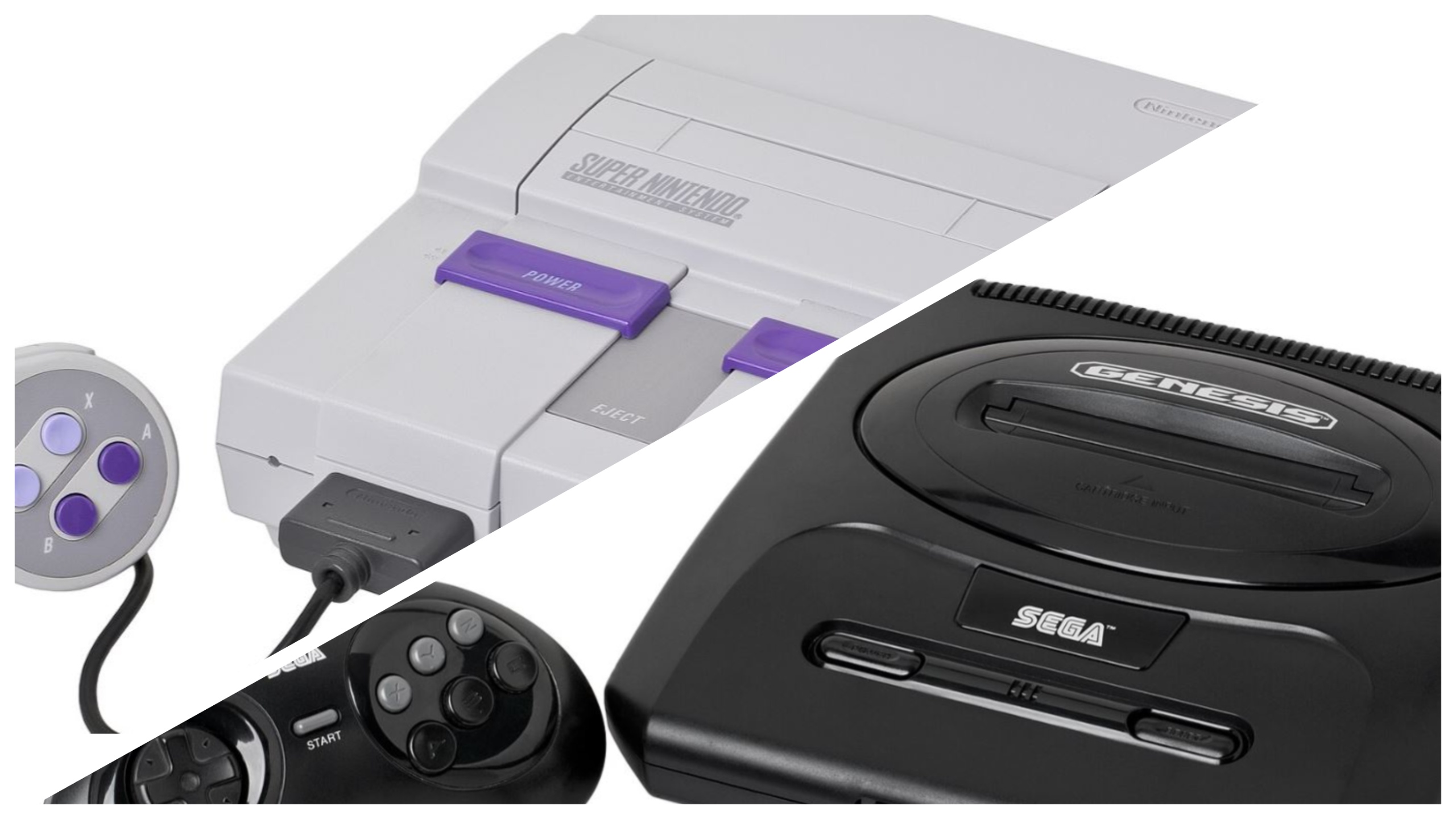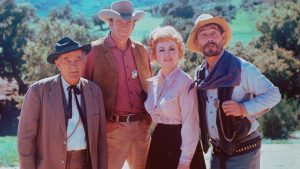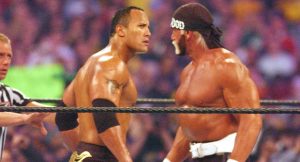
For the last few generations of console video gaming, the landscape has been, more or less, pretty stable. Sony and Microsoft battle for dominance with their cutting-edge machinery while Nintendo lives on with something quaint dependent on their first-party quality. Of course, this wasn’t always the way. There was a time when the world of video games housed a war that defined the extreme ‘90s. It was a time when a company sized up one of the most dominant giants in any industry and briefly won over most of the world by saying, “We’re cooler than them.”
It was the best of times, it was the worst of times. It was the age of plumbers, it was the age of hedgehogs. It was the epoch of green sweat, it was the epoch of blood codes. It was the season of playing it loud, it was the season of being welcomed to the next level. It was the spring of Nintendo, it was the winter of Nintendon’t. Let’s look back at the history of the legendary feud between Nintendo and Sega as they battled on the mountain of 16-bit and beyond.
Nintendo’s Rise to Dominance
There was competition in the second console generation, but there was no real warring. Just different companies doing their thing and working for that sweet, sweet market share. The infamous incident in all of this is the Video Game Crash of 1983, where Atari and the rest oversaturated the US market and just about killed the entire business. What’s important to remember is that the crash was largely localized to North America. Japan was thriving. In fact, 1983 was a pretty big year for Japan in video games. Nintendo released the Famicom while Sega released the SG-1000.
The cream rose to the top and Nintendo’s Famicom became the dominant hardware in Japan. With the video game scene being on fire in the US (but in a bad way), Nintendo held back a bit and took its time choosing how to market the console. By the time the Nintendo Entertainment System hit the scene in 1985, there was nothing that compared. To this audience, it was new, different, and way better. It not only helped video games recover in the US, but it became virtually the only game in town. Atari’s attempts to save face all fell flat.
The Sega Master System Wants to Play
The SG-1000 never did come to the US, nor should it have. Instead, Sega upgraded it a couple of times over, giving us the Sega Mark III in 1985. Much like Nintendo, Sega realized that the aftermath of the crash allowed them a foothold in the US and a way to release the Mark III under the name Sega Master System. While this 8-bit console certainly looked better than the NES graphically, it simply did not stand a chance. Not only was the NES so popular that “Nintendo” was the word people used to describe video games, but Sega just lacked the games to compete. Their first-party stuff was strong, but not Mario/Link/Samus strong, and Sega had very little support from third parties.
The Master System was at least doing slightly better than Atari’s 7800. While Atari was synonymous with the past, Sega had a rising identity as the second place against what was nearly a monopoly. It was something, at least.
Sega Genesis Hits the Scene
Despite the NES being so successful, one cannot stand still for long in the world of technology. NEC tried to push things forward with the release of the 16-bit Turbo Engine/Turbografx-16 in Japan in 1987 and North America in 1989. While a worthy console in its own right, it failed to find success. Still, Sega understood that 16-bit was the way to go. Sega’s Mega Drive was released in Japan in 1988, where it failed to dent the NES’ hold over everything. In 1989, it was released in North America as the Genesis.
By this point, Nintendo had already shown off the early technology for the Super Famicom/Super Nintendo Entertainment System. Sega had a head start, but they needed to make an impact before the SNES caught up with them. This time, Sega would do far better and far more than NEC Home Electronics could ever dream.
Seeing Stars with Michael Jackson’s Moonwalker
Enhanced technology was not enough. Genesis needed titles that could really get people talking. So far Sega had some strong first-party games and a scant few good third-party games, but nothing that was going to get its own Saturday morning cartoon or anything. Not yet. An early strategy was going ham on celebrities. That meant releasing sports games with whoever they could get as a face for the game. Arnold Palmer Tournament Golf, Joe Montana Football, Pat Riley Basketball, and so on.
They even released James “Buster” Douglas Knockout Boxing, which is hilarious because they just threw Buster’s likeness on a port of the game Final Blow immediately after he dethroned Mike Tyson. “Our guy beat up their guy!” Absolutely amazing.
The one celebrity tie-in that really felt like a big deal was Michael Jackson’s Moonwalker: a platformer/beat ‘em up that came out in 1990. This was the first Genesis game that truly felt like a blockbuster, building on the success of the weird anthology movie of the same name. This was when Michael Jackson was riding high between Bad and Dangerous, and just a couple of years before things with him would fly off the rails. Regardless, this would be a fruitful collaboration, and the King of Pop would work with Sega regularly over the years.
Enter: Sonic the Hedgehog
In 1991, the SNES was on its way to the US. Sega’s head start had little to show for it. With only months to go, Sega needed to make a statement before it was too late. That statement would be spearheaded by the star of their upcoming game, Sonic the Hedgehog. He was the platformer who was going to do what Alex Kidd couldn’t do on the Master System: out-Mario Mario. Sonic was going to replace Altered Beast as the pack-in title. Sonic immediately became Sega’s mascot. More importantly, he personified everything Nintendo lacked (from attitude to superior technology). Mario was doing the peace gesture while Sonic was doing the Bruce Lee finger wag.
Thankfully for Sega, Sonic’s game could back up the bragging. It really was that good, and it was something they could really hitch their wagon to before the competition heated up.
Genesis Does What (Super) Nintendon’t
The Super Famicom arrived in Japan in late 1990 and was a success out of the gate. Truth be told, the Mega Drive was never much of a challenger to the Super Famicom in Japan. On the other hand, the Mega Drive dominated the SNES in Europe. It’s in North America where things got interesting.
Nintendo’s 16-bit system did quite well for the 1991 holiday season, but Genesis still had the momentum to beat them in sales. Sega had successfully committed to an ad campaign that went out of its way to talk up how much better Genesis was than anything Nintendo had. Much like Game Gear’s marketing being based on talking down the Game Boy for its lack of color options, Genesis’ identity was about being better and cooler than what Nintendo had to offer.
“Genesis does what Nintendon’t.” “Welcome to the Next Level.” And of course, shoving the buzzword “blast processing” down everyone’s throat. SNES was the new kid on the block, but Genesis was hard at work at turning the masses against it.
Nintendo’s Summer of ‘92
While SNES may have been less “cool” than the Genesis, Nintendo made up for lost time early on. Between April and the first day of September 1992, SNES released some absolute bangers in North America. In that time, we got Contra III: The Alien Wars, The Legend of Zelda: A Link to the Past, Street Fighter II: The World Warrior, Mario Paint, Teenage Mutant Ninja Turtles IV: Turtles in Time, and finally Super Mario Kart. That is an INSANE lineup of games to come out in only a few months.
That lineup says something about how bulletproof Nintendo’s first-party output was as well as the strength of their third-party support. The three third-party games on that list are unique in how they relate to their Genesis counterparts. Genesis had an Alien Wars sequel that came out a full two years later. Their version of that Ninja Turtles game was Hyperstone Heist, which is considered a weaker variant of Turtles in Time and came out months later. As for Street Fighter II, Genesis would eventually get a port of Street Fighter II: Champion Edition over a year later, but they added content from its follow-up, Street Fighter II Turbo, which was already on SNES by that point. Sega was falling behind and needed a way to change the conversation and make up a lot of lost ground.
Sega CD Complicates Things
Sega was still moving forward faster than Nintendo in terms of technology, and their next piece of hardware was an ambitious one. The Sega CD (or Mega CD) was released in North America in late 1992, and certainly seemed like a big deal. This Genesis attachment allowed for more storage and the ability to do full-motion video. Nintendo did try to have Sony and Phillips each work on CD technology, which ultimately went nowhere and basically led to Sony becoming a competitor down the line. Whoops!
The Sega CD had some decent games, was not the runaway success Sega hoped for. While FMV games seemed like a huge step forward at the time, most of the games that used that technology were lousy overall. This included Night Trap, which would become a notable release for reasons we’ll get to later.
Sonic 2sDay Shakes Up the Status Quo
Of course there was a Sonic sequel. Of course it was an excellent follow-up, adding the sidekick Tails and allowing him to be controlled by a second player. Knowing they had a real hit on their hands, Sega wanted the release to matter. Back then, games didn’t have much in terms of strict street dates. They simply rolled out to stores and were put on the shelf whenever. Sonic the Hedgehog 2 did more than that and set a major trend in the process.
While the game came out three days earlier in Japan, it had a set date of November 24, 1992, everywhere else. Sega made a huge production of it, having a big launch party with young adult sitcom actors there like Joey Lawrence, Dustin Diamond, and Jonathan Taylor Thomas. It was a major undertaking to make sure everyone had the game ready on that specific day, but it paid off. Sonic the Hedgehog 2 would be Genesis’ second biggest seller, coming just after its predecessor, which, again, was a pack-in title. Hell, the sequel sold over five times as many as the original pack-in game Altered Beast!
Mortal Monday Draws a Red Line in the Sand
Following Sonic the Hedgehog 2’s example, Midway’s ever-so-popular Mortal Kombat made its journey to homes on Mortal Monday, September 13, 1993. Known for its shocking use of blood and violent Fatality moves, the two 16-bit systems each had solutions to the potential controversy. The Genesis version (as well as Game Gear and Sega CD) was bloodless by default but allowed a code to unlock the bloody effects and more violent Fatalities. Nintendo chose to stick to their guns and take the high road, replacing the blood with green sweat and sanitizing the “Finishing Moves.” Wouldn’t you know it; the Genesis version was a massive hit and outsold the SNES counterpart into oblivion.
Genesis’ perceived port superiority didn’t end there. Mortal Kombat was sandwiched between two other major third-party Genesis titles: Disney’s Aladdin and Jurassic Park. Both games were very different from the SNES titles of the same name but had far more hype and popularity going for them. Genesis Jurassic Park had an in-your-face commercial that explained how that version allowed you to play as a velociraptor. You can’t compete with that.
The Congressional Hearings on Video Game Violence
From late 1993 to early 1994, Senator Joe Lieberman headed congressional hearings to delve into the dangers of violence in video games and the lack of a ratings board. The two big talking point games here were Mortal Kombat and Night Trap. While Mortal Kombat was at least understandable, Night Trap’s infamy was overblown, treating a cheesy FMV game as a dastardly snuff film that children could buy. This notoriety did initially boost sales for the game, but then major retailers pulled it from shelves, so nuts to that.
Nintendo, the goody-two-shoes company, was chided just as much as Sega even though Nintendo of America’s vice president Howard Lincoln did everything he could to distance himself from the situation. He went so far as to say, “Let me say for the record, I want to state that Night Trap will never appear on a Nintendo system.” In the aftermath of these hearings, the Entertainment Software Ratings Board was formed.
Nintendo Plays It Loud
When Mortal Kombat II came to consoles, Nintendo decided to give in and allow the gore. It sold very well, though maybe not an epic all-timer for either console. That didn’t matter. What mattered was that Nintendo was done holding back, and they were willing to get dirt under their fingernails. Third-party titles were getting less different between the two consoles, and Genesis’ advantage was starting to fade.
Not only that, but Nintendo started aping Sega’s marketing with their “Play It Loud” campaign. The company blasted Butthole Surfer songs in their commercials and released Game Boys with different colored plastic as they tried a little too hard to appeal to the rebellious teenage demographic. To back things up, they had some absolute heavy hitters come out in 1994, like Mega Man X, Super Metroid, Super Punch-Out!!, and most importantly Donkey Kong Country. They had plenty of gas in the tank.
Sega wasn’t outright dying, but they had little helping them stick out other than maybe Sonic 3D Blast. They had some solid titles for sure, but Comix Zone and Vectorman weren’t exactly setting the world on fire. Time was running out for Genesis.
A Couple of Failed Science Experiments
As the 16-bit era reached its end, Nintendo and Sega each laid a gigantic egg in terms of hardware. For Nintendo, it was the Virtual Boy. Coming out in 1995, the idea of a blinding, red Game Boy with a depth perception gimmick just did not catch on. At all. It lasted a year before Nintendo wrote it off completely.
In late 1994, Sega released the 32X: an add-on to the Genesis that allowed for 32-bit cartridges. Due to its rushed nature, the lack of third-party support, and being overshadowed by upcoming consoles, the 32X fell flat. Granted, it sold better and lasted longer than Nintendo’s Virtual Boy, but its association with Genesis did the 16-bit console no favors. Once the king of the industry in the US, Genesis walked into the sunset with a loss of luster and the stink of failure.
Stumble Into the Future
As it came time to move into the next two gaming generations, neither side came out unscathed, mainly thanks to Sony’s new PlayStation and its killer follow-up PlayStation 2. As for Nintendo, they made some…interesting decisions with the Nintendo 64 and GameCube. Both consoles did respectable numbers, but they were nowhere near the top of the ladder. The arrival of Microsoft’s Xbox even dropped Nintendo into third place! As for Sega, the Sega Saturn was a Frankenstein monster of next-gen technology released with some of the most questionable, self-sabotaging sales tactics. The Dreamcast was a phenomenal console, but bad timing and a bad reputation from Sega’s previous decisions helped it fail financially.
Sega had to wrap it up. No more consoles for them. They peaked with Genesis, which ultimately had a muddy ending and a flat denouement. They focused on being a third-party developer, which led to Sega games on Nintendo consoles, various Sonic/Mario crossovers, and the biggest shock of all, Night Trap: 25th Anniversary Edition being released for the Nintendo Switch. Yes, that’s right. Howard Lincoln lied under oath. Not only that, but the ESRB gave it a Teen rating anyway! Oh, Howard. Nester would be so disappointed in you.
When the dust settled in the mid-’90s, the Super NES sold more units than the Genesis. But it feels wrong to call Sega the loser. Yes, they fumbled in the aftermath, but both sides made so much money in that feud and reinvigorated the business to the point that the Video Game Crash from a decade earlier felt like ancient history. Genesis drew blood from a juggernaut and helped allow a world where Nintendo wasn’t the only worthwhile game in town.
As for Nintendo, they too came out of the war with a reputation. It’s set in stone that their first-party line-up will always be untouchable, and they aren’t afraid to step out of their comfort zone and switch it up.
The post The Moments That Defined The SNES vs. Sega Genesis Console War appeared first on Den of Geek.





